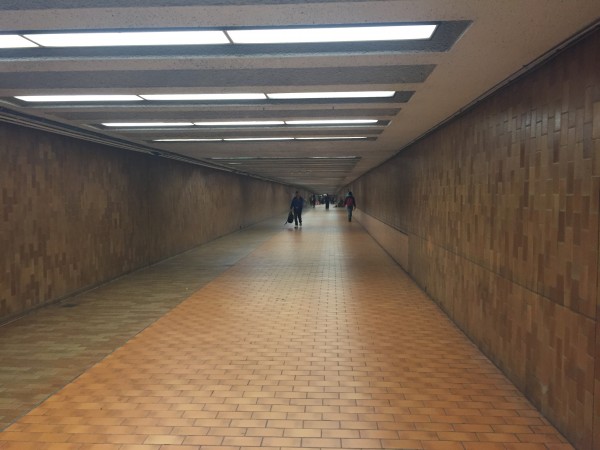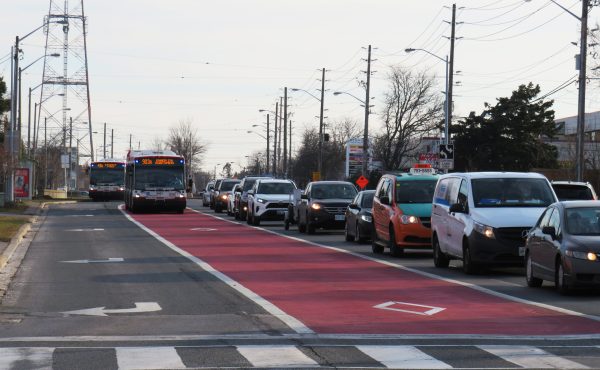Toronto’s four subway routes are easy to navigate. Trains always run the same routes and there are only five interchange stations. Switching lines is mostly as easy as going up or down a flight of stairs. There are few choices to make and it’s hard to get lost or go wrong on the TTC subway system, most of us take the most efficient path all the time just as a function of simplicity.
The exception is the interchange between the Spadina Line and the Bloor Line. For people travelling south on Spadina then west on Bloor – or the reverse – there are two options, (1) get off at Spadina and walk through the long interstation passageway or (2) go an extra stop to St. George switch quickly and take an extra stop back through Spadina heading west.
There is a large body of academic literature that investigates people’s perceptions of time. This is important for the design and operation of public transportation since waiting feels longer than it is; transit users who spend 5 minutes moving on a bus or train tend to be happier than those who spend 5 minutes waiting at a stop (See here or here for examples (PDFs)).
According to Google Maps it takes 1 minute to travel from Spadina Station to St. George Station by TTC. Given that seconds could make a difference in this comparison I decided to measure it the old fashioned way, with a stop watch. I timed from the ringing of the door chimes at one station to stepping off the train at the next. On average, it took me 1 minute and 40 seconds to travel between St.George and Spadina Stations on the north-south Spadina Line and 1 minute and 4 seconds on the east-west Bloor Line. I also walked back and forth between the platforms at Spadina Station where on average it took me 2 minutes and 24 seconds, measured from platform to platform. I walked with purpose but made sure to never run and I was carrying a bag. The wait time once on the platform is on average half the head time between trains. At rush hour in Toronto that is 1 minute and 10.5 seconds. At St. George Stations I have assumed people would rarely miss a train while going up and down the stairs; I am assuming that if the train is in the station most people run for it so I have ignored the time needed to change platforms at St. George Station.
By my measurement, switching at St. George Station is 20 seconds or 14% slower than taking the walk at Spadina Station. None-the-less, changing at St. George may feel faster to many people; the extra time is spent moving on trains rather than walking through a somewhat drab tunnel. Over the course of a year someone changing at Spadina Station as part of a daily commute would save almost 3 hours.
Shoshanna Saxe is an engineer from Toronto. Say hello on twitter @shoshannasaxe





22 comments
Cool experiment. I think that many people simply don’t like to walk any distance, so would automatically prefer the St. George transfer option.
Aside from this, I’m completely flummoxed that the horizontal motorized walkway was removed from the Spadina passageway. As a child I loved riding it for the pure novelty. Now, those things are everywhere…*except* Spadina station. For the less mobile, this seems like a bad and regressive decision.
Yes, what happened to the moving walkway? When I was doing this route many years ago, the sense of speed from walking quickly along the moving walkway felt invigorating compared to standing around waiting for the west bound train to arrive at St. George as multiple east-bound trains went the other way.
The movator is gone because it came time to replace it after numerous repairs, and that would have cost more money than removing it. So it was removed. Or at least, that seems like the most likely story. After all, it’s not required for accessibility reasons so the extra expense would have been difficult to justify merely to enhance riders’ experience.
Cool experiment. Thanks for sharing.
I would think that there’s an added risk of a delay by staying on the train for that extra stop as well that I would personally factor in.
Imagine Line 1 gets a delay while you decide to take that extra stop. There goes your sanity.
That passageway badly needs some art. Or something.
Another thing to consider is that if you use Spadina to transfer to a westbound Bloor train, you’re unlikely to be able to get on the train — they’re just too full. If you board at St George your odds of actually fitting yourself on the 1st train that arrives are somewhat better.
Speed is relative and the amount of work put on walking should be considered as well
Most of us probably need the exercise, so the Spadina walkway is OK. But so drab!!
Yeah, the old people mover would have shifted the preference more towards the Spadina change because a) it would have been a bit faster to walking along it, 2) it meant expending less effort, and c) because it was fun to use!
Take a look at http://transit.toronto.on.ca/subway/5106.shtml.
The Spadina Line Spadina station is really a completely separate station from the Bloor Line Spadina station. The loooong walkway – with or without mechanized transport – was a compromise long after most of the design was done. If it had not existed I’m sure we never would have missed it.
They should return the moving sidewalks. However, instead of one continuous movator in each direction, have people get off halfway and back on to continue. If one movator is out for maintenance, it’ll be just half the distance.
I too would like to know why they removed the motorized walkway. It does seem terribly regressive. I would also like to know when they will install art along the walkway. There is a lovely caribou quilt artwork at the north exit at Kendal from this station and this walkway is screaming for some art!
The operating costs of the energy were pegged at around $100,000 which was too much – done about a decade ago; likely more given how time scuds with scant done, except more stupidities. But no problem in going through at least $75,000,000 in switching away from a funded LRT project in Scarborough to a blighting subway, and there was also a $500,000 severance to TTC CGM Gary Webster for having the temerity to look at facts, and state opinions based on what they indicated.
I personally never walk that Spadina tunnel because I’ve felt unsafe at non peak hours more than once.
And for your next column, can you determine whether it makes more sense to switch at St George and again at Yonge & Bloor when trying to reach stations on the East side of the loop, or just stay on the YUS line and ride the loop?
Fun experiment!
“At St. George Stations I have assumed people would rarely miss a train while going up and down the stairs; I am assuming that if the train is in the station most people run for it so I have ignored the time needed to change platforms at St. George Station.”
In the morning rush heading downtown, it can easily take over a minute just to climb the stairs to the University platform if you’re not one of the first ones off the Bloor train, especially if there’s also a University train unloading upstairs. You physically cannot run for a train, it’s just too congested. So the scales tip even more in favour of Spadina!
After 4 years at U of T taking Line 2 from St. George I decided I hate the noise and rumbling of the Line 1 trains overhead…so I will avoid the Line 2 platform as much as I can.
Yes, what jacquilynne said…ride the loop or not?
I’ll see what I can do about answering the loop questions. I tried it once many years ago and it took a long time. But maybe it just felt like it did.
Along the same lines, I would be curious about the break-even for U of T students traveling to buildings on St. George or Huron: take the train to Spadina and hop on a southbound streetcar, or get off at St. George and walk? Does it just depend which direction you’re coming from on the subway? I never remembered to do the experiment myself.
Thanks for sharing your results and method.
I personally jog when space is available through the tunnel. I normally bike, and usually feel the need for some exercise when on transit. I only use St. George for north to west transfers when tired.
Given the slight 20 second advantage of the St. George transfer, the assumption of zero seconds to get off and head take the stairs to the other platform is problematic. As another poster mentioned, on busy trains it can take a while to get to the St. George stairway and up or down it. I usually have space to jog or at least quickly walk the less popular Spadina Walkway to the relatively empty Spadina Station (1 line).
My wife doesn’t like the walk and always takes the easier stairway like the majority. If she knew for sure that she would miss a train or about take a 3-5 minute penalty for transferring at St.G. she might consider switching.
Two points here:
First, there once was a plan to run the Spadina line as a shuttle north from Spadina (north) station. That’s why there’s a crossover north of it. The tunnel link would be needed for anyone connecting to the BD subway.
Second, A big difference in changing at St. George is that no matter where you are on the train, you are close to a stairway. At Spadina, you must walk down to the south end of the platform just to reach the link up to the tunnel. That extra walk vanishes if you change at St. George.
I prefer the walk at Spadina, especially if I am taking the 510 Streetcar as the walkway ends right where the Streetcar loads up.
If you walk fast the distance isn’t that long, and much better then navigating the mess at St George during rush hour.
Lastly, you get to wiggle your way into your own line for the 510 streetcar as your right ahead of the queue line coming in from the side.
I don’t expect this to ever get busy or “exposed” people will always think St George is quicker when it is actually a mess at times. Only during off-peak hours is that option quicker, especially on Sundays where it appears that trains stop at St George for a few seconds longer then they should.